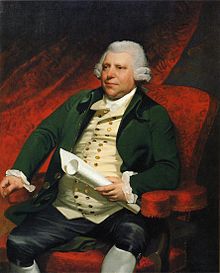
Impressionism was a 19th-century art movement characterized by relatively small, thin, yet visible brush strokes, open composition, emphasis on accurate depiction of light in its changing qualities, ordinary subject matter, unusual visual angles, and inclusion of movement as a crucial element of human perception and experience. Impressionism originated with a group of Paris-based artists whose independent exhibitions brought them to prominence during the 1870s and 1880s.

Mary Stevenson Cassatt was an American painter and printmaker. She was born in Allegheny, Pennsylvania, and lived much of her adult life in France, where she befriended Edgar Degas and exhibited with the Impressionists. Cassatt often created images of the social and private lives of women, with particular emphasis on the intimate bonds between mothers and children.

Edgar Degas was a French Impressionist artist famous for his pastel drawings and oil paintings.

Visual art of the United States or American art is visual art made in the United States or by U.S. artists. Before colonization, there were many flourishing traditions of Native American art, and where the Spanish colonized Spanish Colonial architecture and the accompanying styles in other media were quickly in place. Early colonial art on the East Coast initially relied on artists from Europe, with John White the earliest example. In the late 18th and early 19th centuries, artists primarily painted portraits, and some landscapes in a style based mainly on English painting. Furniture-makers imitating English styles and similar craftsmen were also established in the major cities, but in the English colonies, locally made pottery remained resolutely utilitarian until the 19th century, with fancy products imported.

Thomas Hart Benton was an American painter, muralist, and printmaker. Along with Grant Wood and John Steuart Curry, he was at the forefront of the Regionalist art movement. The fluid, sculpted figures in his paintings showed everyday people in scenes of life in the United States.

American Impressionism was a style of painting related to European Impressionism and practiced by American artists in the United States from the mid-nineteenth century through the beginning of the twentieth. The style is characterized by loose brushwork and vivid colors with a wide array of subject matters but focusing on landscapes and upper-class domestic life.

The Charles Hosmer Morse Museum of American Art, a museum noted for its art nouveau collection, houses the most comprehensive collection of the works of Louis Comfort Tiffany found anywhere, a major collection of American art pottery, and fine collections of late-19th- and early-20th-century American paintings, graphics and the decorative arts. It is located in Winter Park, Florida.

Anne Parrish was an American novelist and writer of children's books. She was a runner-up for the Newbery Medal three times from 1925 to 1951.

Crystal Bridges Museum of American Art is a museum of American art in Bentonville, Arkansas. The museum, founded by Alice Walton and designed by Moshe Safdie, officially opened on 11 November 2011. It offers free public admission.
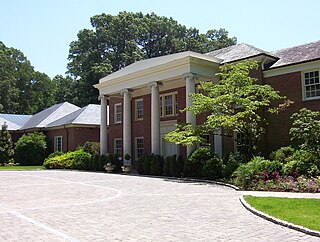
The Dixon Gallery and Gardens is an art museum within 17 acres of gardens, established in 1976, and located at 4339 Park Avenue, Memphis, Tennessee, United States.

The Tuscaloosa Museum of Art, previously the Westervelt-Warner Museum of American Art, was an art museum in Tuscaloosa, Alabama. It was founded by Tuscaloosa businessman Jack Warner. The museum permanently closed in 2018.

Memphis Brooks Museum of Art is an art museum in Memphis, Tennessee. The Brooks Museum, which was founded in 1916, is the oldest and largest art museum in the state of Tennessee. The museum is a privately funded nonprofit institution located in Overton Park in Midtown Memphis.
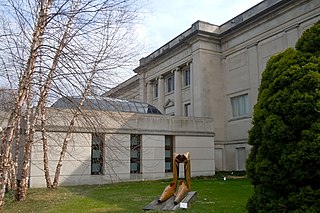
The Reading Public Museum is a museum in Reading, Pennsylvania located in the 18th Ward, along the Wyomissing Creek. The museum's permanent collection mainly focuses on art, science, and civilization and contains over 280,000 objects. It also has a planetarium and a 25-acre (100,000 m2) arboretum.
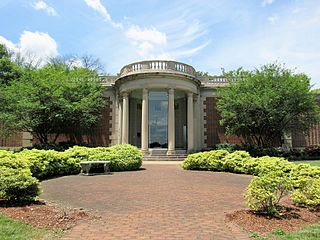
Washington County Museum of Fine Arts (WCMFA) is an art museum located in Hagerstown, Maryland, United States. The building is located off Park Circle and serves as a centerpiece in Hagerstown City Park. The museum was donated in 1929, by Mr. and Mrs. William Singer, Jr. It was completed in 1931, and two wings were added in 1949. The museum provides residents and visitors with access to a nationally recognized permanent collection and a rotating schedule of exhibitions, musical concerts, lectures, films, art classes and special events for children and adults throughout the year. The collections include 19th & early 20th Century American Art, Old Masters, and Decorative art.

The Parrish Art Museum is an art museum designed by Herzog & de Meuron Architects and located in Water Mill, New York, whereto it moved in 2012 from Southampton Village. The museum focuses extensively on work by artists from the artist colony of the South Shore and North Shore.

The Flint Institute of Arts, also called FIA, is located in the Flint Cultural Center in Flint, Michigan. The second largest art museum in Michigan, it offers exhibitions, interpretive programs, film screenings, concerts, lectures, family events and educational outreach programs to people of various ages, serving over 160,000 adults and children a year.

The Palmer Museum of Art is the art museum of Pennsylvania State University, located on the University Park campus in State College, Pennsylvania.

The William Benton Museum of Art is a public fine arts museum located on the University of Connecticut's main campus in Storrs, Connecticut, US. The Benton houses a permanent collection of over 6,500 artistic works and hosts special exhibitions, concerts, campus art walks, and other events. The museum is named in honor of the prominent U.S. senator and university trustee William Benton. The Benton has a cafe and a gift store. Admission to the museum is free for all.

Mother and Child (The Oval Mirror) is an oil-on-canvas painting by Mary Cassatt. The painting depicts a mother and her child in front of a mirror. The painting provides a glimpse of the domestic life of a mother and her child, evoking religious iconography from the Italian Renaissance. However, portrayals of a mother and her child are common in Cassatt's work, so it is possible that this similarity is coincidental rather than intentional.
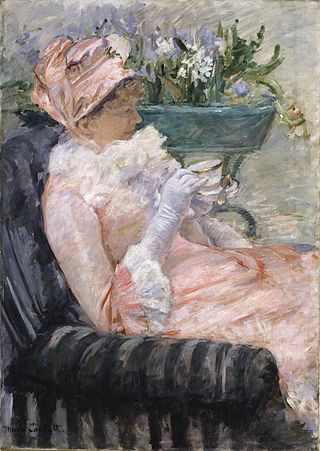
The American artist Mary Cassatt painted The Cup of Tea in Paris ca. 1879–1881. The painting depicts Mary's sister Lydia Cassatt in a typical, upper class-Parisian ritual of afternoon tea. Scholars have observed that Cassatt's choice to employ vivid colors, loose brushstrokes, and unique perspective to portray the scene makes it a quintessentially Impressionist painting.


